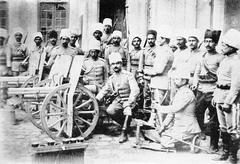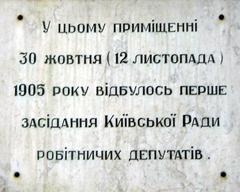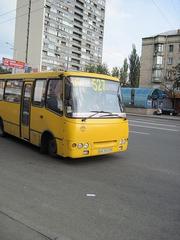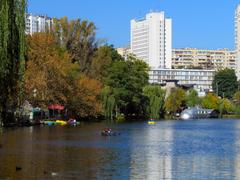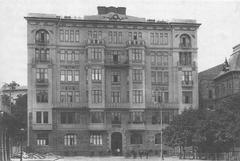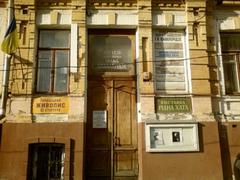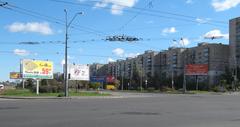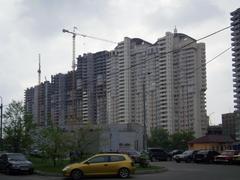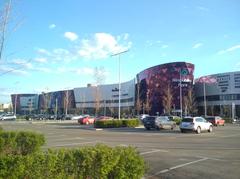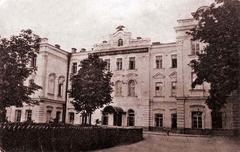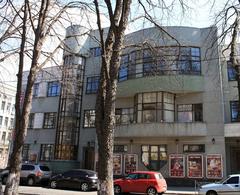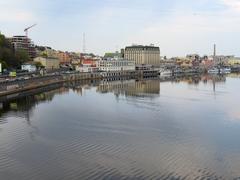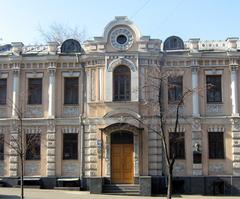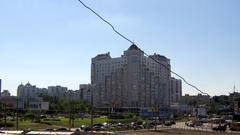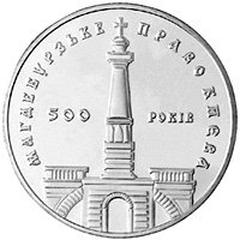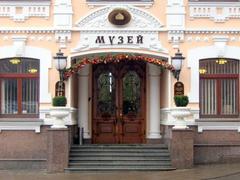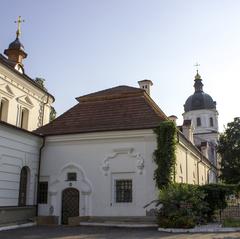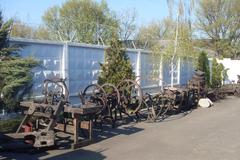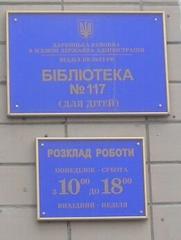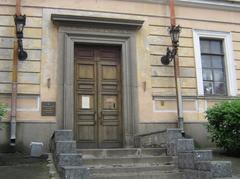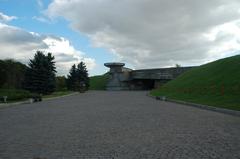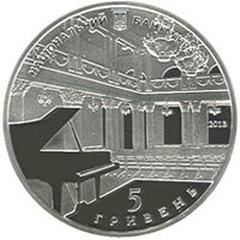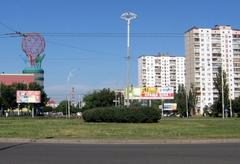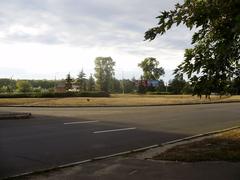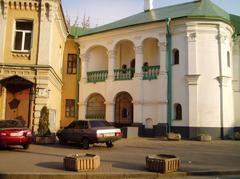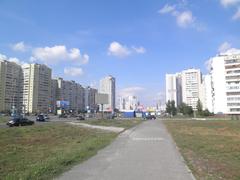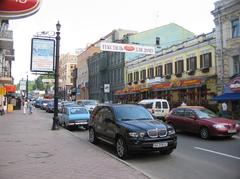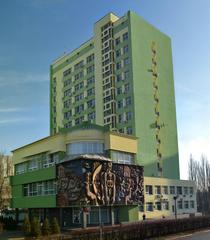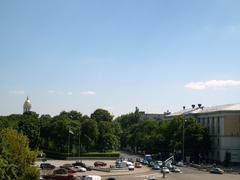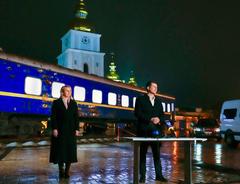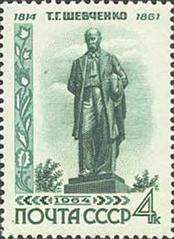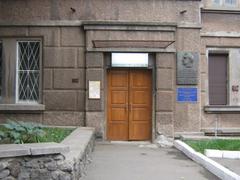Khvoina Street, Kyiv: Visiting Hours, Tickets & Historical Sites Guide
Date: 04/07/2025
Introduction
Khvoina Street, nestled within Kyiv’s tranquil residential quarters, is an under-the-radar destination for those seeking an authentic perspective on the city’s history, architecture, and daily life. While not as widely recognized as Khreshchatyk or Andriyivskyy Descent, Khvoina Street encapsulates the layered evolution of Kyiv—from 19th-century growth through Soviet urban planning to contemporary renewal. Rich in architectural diversity and local character, Khvoina Street invites visitors to explore a quieter, greener, and deeply meaningful side of the Ukrainian capital (Wikipedia: History of Kyiv).
This comprehensive guide covers Khvoina Street’s history, architectural highlights, cultural atmosphere, practical visitor information, and its place within Kyiv’s broader urban story. Whether you’re a history buff, an architecture enthusiast, or a curious traveler, Khvoina Street offers a rewarding window into the city’s multifaceted heritage.
Historical Overview
Early Development and Urban Context
Khvoina Street’s origins date back to Kyiv’s late 19th- and early 20th-century expansion, a period characterized by rapid urbanization and the integration of new residential districts. The street’s name, derived from the Ukrainian word for “coniferous,” reflects its beginnings among pine groves on the city’s outskirts. As Kyiv’s tram and rail networks extended, Khvoina Street developed as a peaceful, green enclave, attracting residents seeking respite from the bustling center (Wikipedia: History of Kyiv; Britannica: Kyiv History).
Soviet Transformation
The Soviet era brought sweeping changes to Khvoina Street’s landscape. Following Kyiv’s designation as the capital of the Ukrainian SSR in 1934, the area saw the construction of standardized apartment blocks and communal facilities. The “microdistrict” model, integrating residential and recreational amenities, shaped Khvoina Street’s mid-century character. Post-war reconstruction introduced Khrushchyovka-style buildings, emphasizing utilitarian design and communal living (Wikipedia: History of Kyiv; Wikipedia: Post-war Soviet Ukraine).
Post-Independence Renewal
After Ukraine gained independence in 1991, Khvoina Street underwent another transformation. Privatization, renovation, and selective new construction brought contemporary styles and amenities, while community-driven preservation efforts ensured the survival of green spaces and historic facades. Today, the street is a harmonious blend of pre-war houses, Soviet apartment blocks, and modern developments (Britannica: Evolution of the Modern City).
Architectural and Cultural Highlights
Architectural Diversity
Khvoina Street’s eclectic streetscape tells a story of Kyiv’s urban evolution:
- 19th-century influences: Early masonry houses with modest classical ornamentation and courtyard layouts.
- Art Nouveau and early 20th-century touches: Decorative facades, pastel stucco, and wrought-iron balconies in select homes (architecturecourses.org).
- Soviet-era Khrushchyovkas: Five-story, functionalist buildings surrounded by mature trees and communal gardens (newsukraine.rbc.ua).
- Modern infill: Recent low- and mid-rise constructions respecting the street’s established scale and blending modern materials with traditional forms (ukraine.ua).
Streetscape Features
- Cobblestones and Narrow Sidewalks: Restored stone paving, lined with mature chestnut and linden trees, evokes Kyiv’s “City of Chestnuts” identity (worldcityhistory.com).
- Decorative metalwork: Unique gates, fences, and balcony railings add visual interest.
- Courtyards: Semi-public green spaces where residents gather, fostering a strong sense of community.
- Understated lighting: Classic-style lampposts and functional street furniture maintain a harmonious public realm.
Interior Atmosphere
Older homes retain high ceilings, wooden beams, and decorative stoves, while Khrushchyovka apartments feature compact, efficient layouts. Many interiors have been modernized, blending tradition with comfort.
Local Culture and Community
Khvoina Street is a microcosm of Kyiv’s diversity, home to Ukrainian, Russian, Jewish, and other communities over the decades. Neighbors socialize in shared courtyards and gardens, and the street’s human scale encourages a village-like atmosphere. Seasonal changes—from spring blossoms to snowy winter evenings—add to its charm and tranquility (futurehubs.eu).
Visiting Khvoina Street: Practical Guide
Location & Accessibility
Khvoina Street is easily accessible by Kyiv’s public transport:
- Metro: The nearest stations are typically a 10–15 minute walk away. A metro ride costs 8 UAH; tickets are available at kiosks or via contactless payment (MyWanderlust).
- Buses & Marshrutkas: Frequent service connects the area to the rest of the city.
- Taxis & Ride-hailing: Apps like Uklon and Bolt offer affordable options.
For those arriving by air, Zhuliany Airport is closest, while Borispol Airport connects to the city center via direct train.
Visiting Hours & Tickets
Khvoina Street is a public thoroughfare with no entrance fees or official visiting hours. Daytime visits (9:00 AM – 7:00 PM) are recommended for safety and to appreciate the atmosphere. Most buildings are private residences; admire facades from the street and avoid entering courtyards unless invited.
Best Time to Visit
- Spring and Early Autumn: Mild weather, blooming trees, and vibrant street life.
- Summer: Warmest, with long daylight hours.
- Winter: Quiet and picturesque, though sidewalks may be icy.
Language & Etiquette
Ukrainian is the official language; Russian is also common. English is not widely spoken on Khvoina Street, so basic phrases or a translation app are helpful. Greet shopkeepers with “dobryi den,” dress neatly, and tip 5–10% in restaurants. Always ask before photographing individuals.
Safety & Health
Khvoina Street is generally safe; take standard precautions. Drink bottled water; pharmacies and clinics are nearby for minor needs (MyWanderlust). Check current travel advisories given the regional situation (wartours.in.ua).
Amenities & Local Services
Local stores, bakeries, pharmacies, and markets serve daily needs. For larger shopping, malls like Ocean Plaza are nearby (MyTravelation). SIM cards are affordable and widely available; free Wi-Fi is common in cafes.
Accommodation
While Khvoina Street is residential, accommodations are available in adjacent neighborhoods, especially near Zolote Vorota metro station. Options range from budget hostels to luxury hotels (MyWanderlust; MyTravelation).
Dining
Enjoy local Ukrainian cuisine—borscht, varenyky, chicken Kyiv—at neighborhood cafes. Meals are affordable, typically 80–200 UAH (€2–€5).
Guided Tours
While dedicated tours of Khvoina Street are rare, some walking tours of Kyiv’s lesser-known neighborhoods include it on their routes. Guided walks provide deeper context on architecture and community life (tourspilot.com).
Nearby Historical Sites and Attractions
Khvoina Street is a short ride from several major Kyiv landmarks:
- Kyiv Pechersk Lavra: UNESCO World Heritage Site (MyTravelation).
- St. Sophia’s Cathedral: Famous for mosaics and frescoes.
- Andriyivskyy Descent: Historic street known for art galleries.
- Khreshchatyk: The city’s main boulevard.
- Motherland Monument: Panoramic city views.
- Holosiivskyi and Mariinsky Parks: Green escapes for relaxation.
Visitor Tips
- Wear comfortable shoes for cobblestones and narrow sidewalks.
- Bring a camera for the street’s unique architectural and seasonal details.
- Visit local markets for fresh produce and crafts.
- Respect residents’ privacy and the residential nature of the street.
Frequently Asked Questions (FAQ)
Q: Are there any entrance fees or tickets required to visit Khvoina Street?
A: No, Khvoina Street is public and free to access.
Q: What are the best hours to visit?
A: Daytime (9:00 AM – 7:00 PM) is recommended for safety and full appreciation.
Q: Is Khvoina Street wheelchair accessible?
A: Sidewalks are narrow and some cobblestone sections may be challenging for wheelchair users.
Q: Can I enter courtyards or private buildings?
A: Access is by invitation only; admire from the street.
Q: Are guided tours available?
A: Some walking tours include Khvoina Street; check with local operators.
Q: Is it safe to visit Kyiv and Khvoina Street currently?
A: Generally yes, but consult current travel advisories and follow local guidance.
Preservation and Modern Identity
Khvoina Street’s preservation is a collaborative effort, driven by both municipal policy and community advocacy. Residents prioritize maintaining green spaces and restoring historic facades, ensuring the street remains an oasis of heritage amid Kyiv’s ongoing development (Secret Attractions: Kyiv Hidden Historical Sites; futurehubs.eu). Today, Khvoina Street stands as a testament to the city’s ability to balance progress with respect for its past.
Visuals and Media
For the best experience, include high-quality images of Khvoina Street’s residential architecture, cobblestone pavements, and leafy sidewalks. Use descriptive alt tags such as “Khvoina Street Kyiv architecture” and “Khvoina Street cobblestone pavement.” An interactive map highlighting nearby historical sites enhances visitor planning.
Conclusion
Khvoina Street is a hidden gem in Kyiv’s urban landscape, offering peace, architectural richness, and community warmth away from the city’s main tourist routes. Easily accessible, free to visit, and steeped in local history, it’s an ideal destination for travelers seeking a deeper connection with Kyiv’s authentic spirit. Whether exploring independently or as part of a guided tour, Khvoina Street promises an intimate and memorable experience.
Call to Action
Ready to discover Kyv’s lesser-known treasures? Download the Audiala app for guided audio tours, offline maps, and up-to-date insights on Khvoina Street and other Kyiv historical sites. Explore related articles on our website and follow us on social media for the latest travel tips and local events.
Sources and Further Reading
- Wikipedia: History of Kyiv
- Britannica: Kyiv History
- Britannica: Evolution of the Modern City
- FutureHubs: Kyiv Ukraine - The Story of Urban Renewal and Community Transformation
- MyWanderlust: Visit Kiev Ukraine
- Secret Attractions: Kyiv Hidden Historical Sites
- newsukraine.rbc.ua: How Old is Kyiv Really?
- architecturecourses.org: Ukrainian Architecture
- ukraine.ua: Kyiv Region
- worldcityhistory.com: The Fascinating History of Kyiv
- MyTravelation: Kyiv
- tourspilot.com: Things to Do in Kyiv
- wartours.in.ua: Traveling to Ukraine During the War in 2025
